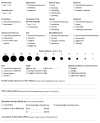Towards the Validation of an Observational Tool to Detect Impaired Drivers-An Online Video Study
- PMID: 35742798
- PMCID: PMC9223496
- DOI: 10.3390/ijerph19127548
Towards the Validation of an Observational Tool to Detect Impaired Drivers-An Online Video Study
Abstract
Abuse of alcohol and other drugs is a major risk factor at work. To reduce this risk, workplace drug testing is performed in transportation and other industries. VERIFY, an observational method, is one of the key elements in a procedure adopted by the police of the canton of Zurich, Switzerland, for detecting impaired drivers. The observational method has been successfully applied by adequately trained police officers since 2014. The aim of this study is to examine the interrater reliability of the observational method, the effect of training in use of the method, and the role of having experience in the police force and traffic police force on the outcome when rating a driver's impairment. For this purpose, driver impairment in staged road traffic controls presented in videos was rated by laypeople (n = 81), and police officers without (n = 146) and with training (n = 172) in the VERIFY procedure. In general, the results recorded for police officers with training revealed a moderate to very good interrater reliability of the observational method. Among the three groups, impaired drivers were best identified by officers with training (ranging between 82.6% and 89.5% correct identification). Trained officers reported a higher impairment severity of the impaired drivers than the other two groups, indicating that training increases sensitivity to signs of impairment. Our findings also suggest that online video technology could be helpful in identifying impaired drivers. Trained police officers could be connected to a road traffic control to make observations via live video. By this method efficiency and reliability in detecting abuse of alcohol and other drugs could be improved. Our findings also apply to workplace drug testing in general.
Keywords: accident prevention; impaired driving; video-based training; workplace drug testing.
Conflict of interest statement
The authors declare no conflict of interest.
Figures


Similar articles
-
Police documentation of drug use in injured drivers: Implications for monitoring and preventing drug-impaired driving.Accid Anal Prev. 2018 Sep;118:200-206. doi: 10.1016/j.aap.2018.02.018. Epub 2018 Feb 23. Accid Anal Prev. 2018. PMID: 29482896
-
What are the factors that contribute to road accidents? An assessment of law enforcement views, ordinary drivers' opinions, and road accident records.Accid Anal Prev. 2018 Jun;115:11-24. doi: 10.1016/j.aap.2018.02.025. Epub 2018 Mar 9. Accid Anal Prev. 2018. PMID: 29529397
-
Randomly controlled drivers using minimally invasive sampling: assessment of drug prevalence in Western Switzerland over two time periods.BMC Public Health. 2022 Dec 28;22(1):2446. doi: 10.1186/s12889-022-14883-2. BMC Public Health. 2022. PMID: 36577956 Free PMC article.
-
Visual attention and the transition from novice to advanced driver.Ergonomics. 2007 Aug;50(8):1235-49. doi: 10.1080/00140130701318707. Ergonomics. 2007. PMID: 17558667 Review.
-
Driving under the influence of psychoactive substances - A historical review.Forensic Sci Rev. 2019 Jul;31(2):103-140. Forensic Sci Rev. 2019. PMID: 31270058 Review.
Cited by
-
The Redesign of a Checklist for Evaluating Driver Impairment: A Human Factors and Ergonomics Approach.Healthcare (Basel). 2022 Jul 12;10(7):1292. doi: 10.3390/healthcare10071292. Healthcare (Basel). 2022. PMID: 35885818 Free PMC article.
-
Mapping the evidence on the assessment of fitness to work at heights: a scoping review.BMJ Open. 2025 Mar 29;15(3):e093525. doi: 10.1136/bmjopen-2024-093525. BMJ Open. 2025. PMID: 40157736 Free PMC article.
References
-
- WHO . Global Status Report on Road Safety. WHO; Geneva, Switzerland: 2018.
-
- García-Herrero S., Gutiérrez J.M., Herrera S., Azimian A., Mariscal M.A. Sensitivity Analysis of Driver’s Behavior and Psychophysical Conditions. Saf. Sci. 2020;125:104586. doi: 10.1016/j.ssci.2019.104586. - DOI
-
- Bragazzi N.L., Dini G., Toletone A., Rahmani A., Montecucco A., Massa E., Manca A., Guglielmi O., Garbarino S., Debarbieri N., et al. Patterns of Harmful Alcohol Consumption among Truck Drivers: Implications for Occupational Health and Work Safety from a Systematic Review and Meta-Analysis. Int. J. Environ. Res. Public Health. 2018;15:1121. doi: 10.3390/ijerph15061121. - DOI - PMC - PubMed
Publication types
MeSH terms
Substances
LinkOut - more resources
Full Text Sources

